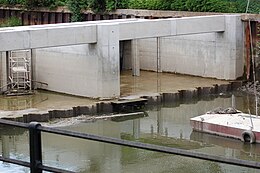| Three Mills Wall River Weir | |
|---|---|
 The weir being constructed in the Three Mills Wall River | |
|
| |
| 51°31′44″N 0°00′14″W / 51.529°N 0.004°W | |
| Waterway | Bow Back Rivers |
| County |
Newham Greater London |
| Operation | Canal & River Trust |
| First built | 2008–09 |
| Fall | tidal |
| Works in conjunction with Three Mills Lock and sluice | |
Three Mills Wall River Weir is a weir on the Bow Back Rivers, in Mill Meads in the London Borough of Newham, England, near to Three Mills. It was built in 2009, when the Bow Back Rivers were refurbished to make them a key feature of the Queen Elizabeth Olympic Park, and maintains water levels through much of the park in conjunction with the Three Mills Lock and sluice on the Prescott Channel.
History
There have been tide mills at Three Mills since at least the time of the Domesday Book. They were fed by the waters of the River Lea, supplemented by tidal water which flowed up the Bow Back Rivers from the River Thames, and powered the mills as the tide fell. [1] The mills were supplied by the Three Mills Wall River, and prior to the reconstruction of the rivers as part of a flood defence project in the 1930s, by Three Mills Back River. There was also a weir from Bow River, the section of the Lee Navigation between Bow Locks and Old Ford Lock. [2] As part of the 1930s scheme, Three Mills Back River was filled in, and a flood relief channel called Prescott Channel was built which enabled flood flows to bypass the mills when required. The new channel incorporated a sluice, which maintained the water levels normally, so that the mills could still operate. [3]
By the 1930s, there were only two mills left at Three Mills. They were used for milling corn, much of which was subsequently used to distill gin, but House Mill ceased operation in 1941, and Clock Mill followed in 1952. [1] The sluice on the Prescott Channel seized up in the 1960s [3] but with the mills no longer operating, it was effectively redundant and was subsequently removed. [4]
The Bow Back Rivers were difficult to navigate, since at low tide there was insufficient water, and at high tide, there was inadequate headroom, particularly where the channels were crossed by the Northern Outfall Sewer. [5] As part of the regeneration of the area connected with the 2012 London Olympics, plans were developed for the refurbishment of the rivers, to maintain them at an intermediate level. [6] It was hoped that they could be used to deliver significant volumes of building materials for the construction of the stadium. [7] In order to achieve this, a new lock and sluice structure was built on the Prescott Channel, but in order to maintain water at the desired levels, a sluice to prevent water bypassing the new structure was necessary on the Three Mills Wall River, and so Three Mills Wall River Weir was built a short distance above Three Mills. [6]
The weir has been constructed across the Three Mills Wall River (also known as Shortwall) by British Waterways. [8] In conjunction with Three Mills Lock and sluice, the two structures stabilise levels at 7.5 feet (2.3 m) above ordnance datum (AOD) around the Queen Elizabeth Olympic Park, whereas they used to rise to 15.8 feet (4.8 m) AOD previously. [6] The structures came into operation in 2009. [9] [10]
The mill pound above House Mill and Clock Mill used to extend northwards to the Lea Bridge Sluices at Lea Bridge Road, but is now very small. House Mill was acquired by the River Lea Tidal Mill Trust Ltd in 1985, and has since been refurbished and opened to the public. The mill wheels are not yet operational, and will not now be tidal, but flow through the new weir could enable them to operate again, and there are hopes that they could be used to generate hydroelectricity. [1]
See also
Bibliography
- BW-London (August 2006). "Prescott Channel Water Control Structure" (PDF). British Waterways. Archived from the original (PDF) on 19 February 2012.
- Thomas, Richard (2010). Bow Back Rivers. History of the Lee and Stort Navigation. Richard Thomas.
References
- ^ a b c "Three Mills". Engineering Timelines. Retrieved 6 March 2012.
- ^ Thomas 2010
- ^ a b "Waterways face new Olympian task". BBC News. 6 April 2008.
- ^ "Bow Back Rivers - A potted history". British Waterways. Archived from the original on 7 February 2012.
- ^ "Restoration Plans". British Waterways. Archived from the original on 22 November 2010. Retrieved 27 February 2012.
- ^ a b c BW-London 2006, pp. 5–6
- ^ BW-London 2006, p. 2
- ^ Revitalising London’s Olympic Waterways Archived 26 September 2008 at the Wayback Machine ( British Waterways) accessed 29 March 2010
- ^ "Three Mills Lock". British Waterways. Archived from the original on 2 October 2009. Retrieved 29 March 2010.
- ^ "Waterway revived as Olympic route". BBC News. 5 June 2009.